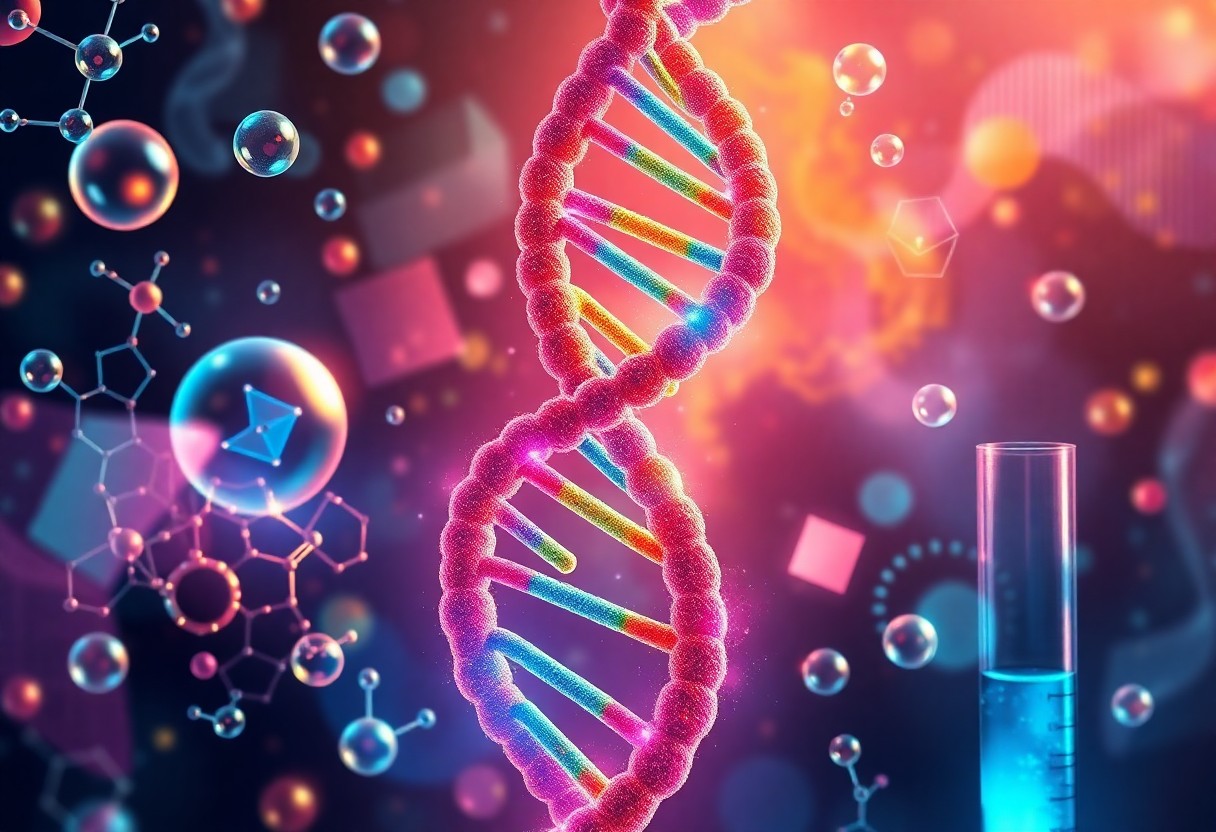DNA is the blueprint of life, storing the instructions needed for the development and functioning of all living organisms. In this post, you will explore the pioneering research that led to the discovery of its iconic double helix structure, a finding that not only advanced genetics but also paved the way for innovations in medicine and biotechnology. You’ll learn about the key players, groundbreaking techniques, and the profound impact this discovery continues to have on science and society today.
The Discovery of DNA
While many scientists contributed to the understanding of genetics, it wasn’t until the 20th century that the structure of DNA was identified, radically changing our perception of heredity. The groundbreaking work of various researchers led to the acknowledgment of DNA as the fundamental molecule of life, providing insight into how traits are inherited and passed through generations. This discovery has had profound implications for biology, medicine, and genetics, forever altering the landscape of scientific inquiry.
Early Studies of Inheritance
Between the late 19th and early 20th centuries, several researchers explored the principles of inheritance, revealing that traits were passed from parents to offspring. Gregor Mendel’s work on pea plants laid the foundation for understanding heredity through discrete units, which are now known as genes. His meticulous experiments illustrated patterns of inheritance, providing a framework that later facilitated the study of DNA.
Key Figures in DNA Research
An vital aspect of DNA research involves iconic figures who paved the way for our comprehension of genetics. These pioneers conducted experiments and collaborated, uncovering information that would eventually lead to the discovery of the double helix structure of DNA.
Understanding the contributions of these pivotal individuals is vital to appreciating the evolution of genetic science. James Watson and Francis Crick are perhaps the most renowned for their discovery of the double helix structure in 1953, which illuminated the molecular arrangements that allow DNA to replicate and code for life. Additionally, the work of Rosalind Franklin, through her X-ray diffraction images of DNA, provided key insights that aided in this discovery, showcasing how collaboration and interdisciplinary efforts were instrumental in evolving our understanding. The ongoing research sparked by these foundational figures continues to transform medicine and is vital to advancements in biotechnology today.
The Structure of DNA
Some people often wonder what makes DNA so remarkable. Its unique double helix structure is not just aesthetically pleasing; it plays a vital role in storing and transmitting genetic information. This configuration, discovered by Watson and Crick, allows DNA to replicate accurately and evolve over time, making it the foundation of all life forms on Earth.
Chemical Composition
Composition of DNA involves four crucial nucleotides—adenine (A), thymine (T), cytosine (C), and guanine (G)—each comprising a phosphate group, a sugar molecule, and a nitrogenous base. The arrangement of these components is integral to the genetic code, determining how genetic information is stored and expressed in living organisms.
The Role of Nucleotides
On a fundamental level, nucleotides serve as the building blocks of DNA, linking together to form the structure of the double helix. Each sequence of nucleotides corresponds to specific genetic instructions that guide your cellular functions, development, and responses to the environment. A single alteration in a nucleotide can lead to significant changes in your traits, some of which can be beneficial, while others may pose health risks. Understanding the role of these nucleotides is vital to grasping how genetic information impacts your life and contributes to the diversity of life. Their arrangement ultimately shapes your very being and potential.
The Race for the Double Helix
There’s no denying that the quest to uncover the structure of DNA was a fierce competition. Scientists like James Watson, Francis Crick, and Rosalind Franklin engaged in a race against time, each driven by a deep desire to understand the secret behind genetic codes. Their efforts not only reshaped the field of biology but also accelerated advancements in genetics and medicine. This narrative of rivalry and collaboration ultimately led to the monumental discovery of the double helix structure, forever changing our understanding of life itself.
Watson and Crick
Before plunging into the experimental efforts, it’s imperative to highlight the partnership between James Watson and Francis Crick. Their collaboration at Cambridge University blended creativity with scientific rigor, leading to the proposal of the double helix model. Utilizing existing data and critical insights, they decoded the structure of DNA in a way that brought clarity to its complex role in heredity.
The Contribution of Rosalind Franklin
Contribution to the discovery of DNA’s structure is often overlooked, but Rosalind Franklin’s work was invaluable. Her pioneering techniques in X-ray crystallography provided key insights into the molecular arrangement of DNA. These images illuminated the helical structure, laying the groundwork for Watson and Crick’s model.
In addition to her innovative X-ray crystallography, Rosalind Franklin’s meticulous experiments revealed the dimensions and shape of DNA, which were critical for understanding its biological function. Despite facing gender biases in a male-dominated field, her resilience and dedication to science paved the way for future discoveries. Her contributions were fundamental, yet they were often overshadowed by her male counterparts, highlighting the importance of recognizing all contributors to scientific advancement.
Implications of the Double Helix Model
Unlike earlier models that failed to explain heredity adequately, the double helix structure of DNA has transformed our understanding of genetic inheritance and molecular biology. This discovery laid the groundwork for new fields, including genetic engineering and genomics, allowing you to explore the inner workings of life at the molecular level. The implications of this model extend beyond biology, influencing medicine, forensics, and anthropology, thus reshaping our perspective on evolution and diversity.
Genetic Information Storage
Above the complexities of life lies the remarkable ability of DNA to store vast amounts of genetic information. This information is encoded in sequences of nucleotides, and you can think of it as a biological blueprint, guiding the development and functioning of all living organisms. This efficient data storage system allows cells to replicate and pass on critical traits to future generations.
Advances in Biotechnology
After the discovery of the double helix, biotechnology has seen rapid advancements that have revolutionized various fields. You are now living in an era where genetic engineering, such as CRISPR technology, enables precise modification of DNA, setting the stage for breakthroughs in medicine and agriculture.
Advances in biotechnology have opened doors to numerous innovative applications, like gene therapy to treat genetic disorders and the development of genetically modified organisms (GMOs) that enhance crop yields. However, with these remarkable breakthroughs come ethical concerns regarding genetic manipulation and potential consequences for human health and biodiversity. You must consider these critical debates as biotechnology continues to evolve, promising both exciting possibilities and serious challenges for the future.
DNA Replication and Function
For the preservation of genetic information, DNA undergoes a complex process called replication. This is fundamental to cell division, ensuring that each new cell inherits an identical copy of the DNA. Your cells rely on this meticulous copying mechanism to maintain genetic integrity and support life processes.
Mechanisms of Replication
For understanding DNA replication, you should know that it primarily involves the unwinding of the double helix, followed by complementary base pairing and strand elongation. Specialized enzymes, such as DNA polymerase, play significant roles in facilitating this process, ensuring that your genetic information is accurately duplicated.
Importance in Cell Biology
Cell biology underscores the significance of DNA replication as it is important for growth, development, and maintenance.
A proper understanding of DNA replication allows you to appreciate its role in cellular function and how it contributes to genetic diversity. Errors in this process can lead to mutations that might result in diseases such as cancer. Furthermore, the ability of cells to replicate their DNA accurately is vital for organismal development and tissue repair, making it a cornerstone of biological health and function.
Modern Applications of DNA Research
Now, DNA research has led to transformative applications across various fields, shaping the future of medicine, forensics, and agriculture. From genetic testing to personalized medical treatments, the potential is vast. Understanding your own DNA can unlock insights about your ancestry, health risks, and tailored therapies, revolutionizing the way you approach your well-being.
Genetic Engineering
Among the most exciting advancements in DNA research is genetic engineering, which allows scientists to modify organisms at the genetic level. This technique is used to create genetically modified crops that resist pests and enhance nutritional value, ultimately benefiting your food supply. However, it also raises ethical questions about genetic manipulation, prompting discussions on safety and sustainability.
Forensics and Medical Research
Around the globe, DNA research has transformed forensics and medical research, providing tools for identifying individuals and diagnosing diseases. Techniques like DNA profiling help solve crimes by providing irrefutable evidence, while advancements in genetic research lead to breakthrough treatments for hereditary conditions.
But as you explore the realms of forensics and medical research, you must be aware of the potential risks and challenges. The accuracy of DNA evidence in criminal cases can impact innocent lives, while ethical concerns about genetic data privacy remain pressing. However, the positive aspects are undeniable: early disease detection can save lives, and personalized medicine enhances treatment efficacy, offering you the promise of a healthier future.
To wrap up
Conclusively, you have explored the significant journey of how scientists unraveled the structure of DNA’s double helix. By understanding the pivotal roles played by figures such as Watson, Crick, and Franklin, you grasp the collaboration and ingenuity that led to this monumental discovery. This knowledge not only highlights the intricacies of molecular biology but also underscores the importance of scientific inquiry in advancing our comprehension of genetics and heredity. Recognizing these groundbreaking steps empowers you to appreciate the foundational concepts driving modern science.
FAQ
Q: What is the main focus of “Unraveling Science – The Groundbreaking Steps Behind DNA’s Double Helix”?
A: The book explores the historical context, experimental techniques, and key figures involved in the discovery of the double helix structure of DNA. It explores into the scientific methods used in molecular biology and highlights the collaborative efforts of scientists like James Watson, Francis Crick, Rosalind Franklin, and others who contributed to this major breakthrough in genetics.
Q: Who are the key figures discussed in the book?
A: The book discusses several pivotal scientists, including James Watson and Francis Crick, who are credited with proposing the double helix model, and Rosalind Franklin, whose X-ray diffraction images were critical in revealing DNA’s structure. Additionally, the contributions of Maurice Wilkins and other contemporaries in the field of genetics are examined, showcasing the teamwork and competition among these researchers during this period of discovery.
Q: How does the book convey the scientific process behind the discovery of DNA’s structure?
A: “Unraveling Science” employs a narrative approach, incorporating detailed descriptions of experiments, discussions on the use of technology in research, and insights into the challenges faced by scientists. It emphasizes the iterative process of hypothesis testing, data gathering, and peer collaboration, illustrating how scientific knowledge evolves over time through rigorous investigation and incremental discoveries.
Q: What role did technology play in the discovery of DNA’s double helix?
A: The book highlights the significance of technological advancements, particularly X-ray crystallography, which was used by Rosalind Franklin to obtain crucial images of DNA. It also discusses the importance of model-building techniques employed by Watson and Crick to visualize the molecular structure. The integration of these technological tools paved the way for understanding complex biological molecules and facilitated a deeper comprehension of molecular genetics.
Q: What impact did the understanding of DNA’s structure have on the field of biology?
A: The elucidation of DNA’s double helix structure marked a transformative moment in biology, laying the foundation for modern molecular genetics. It has led to advancements in various fields including genetic engineering, biotechnology, and medicine. The information gained from understanding DNA’s structure has enabled researchers to develop techniques such as DNA sequencing, genetic modification, and targeted therapies, thereby revolutionizing our approach to disease treatment and prevention.
source link eu news




















